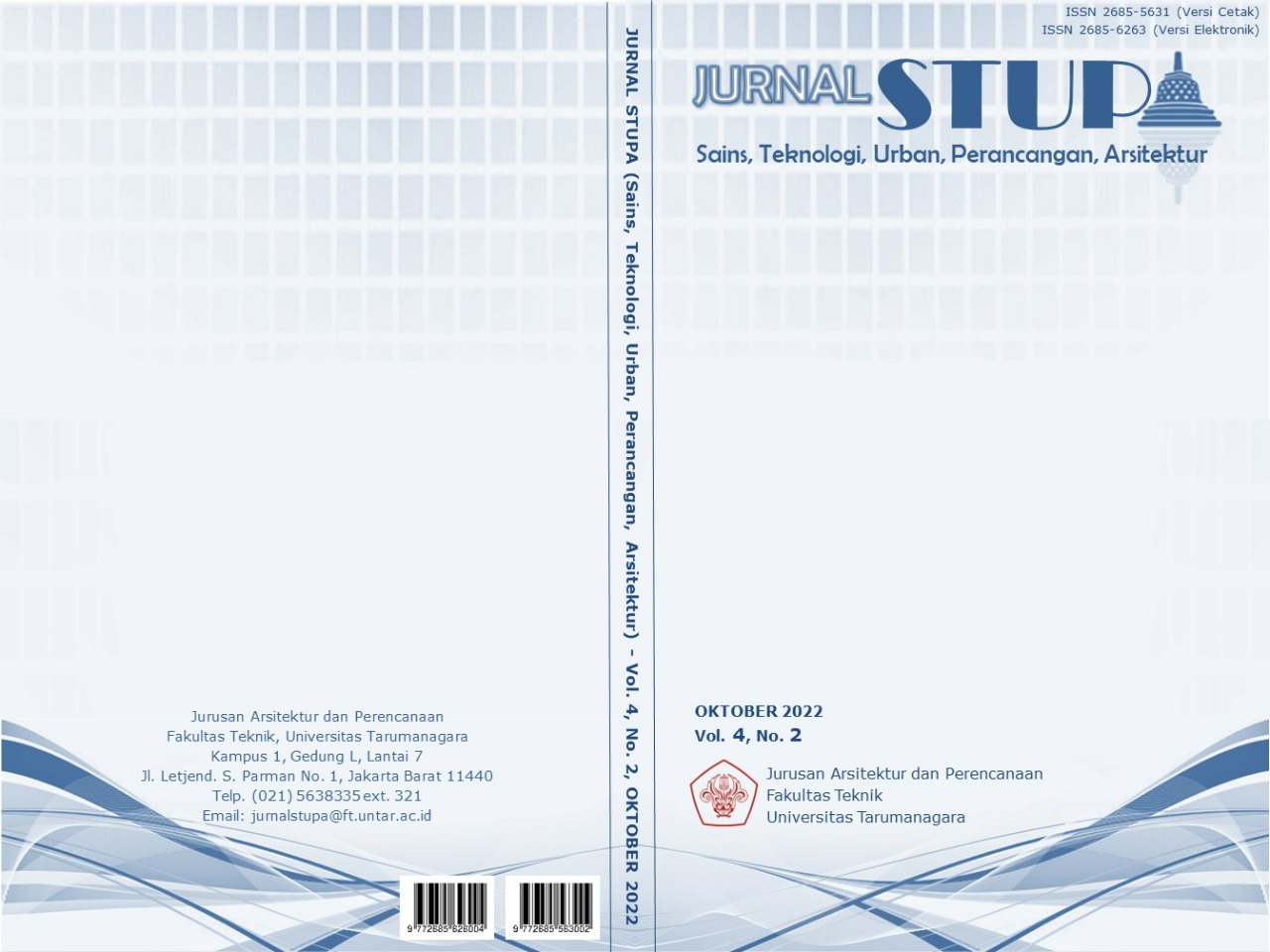MENGHIDUPKAN KAWASAN PECENONGAN MELALUI KEGIATAN KULINER JALANAN DAN PUSAT REKREASI DENGAN STRATEGI AKUPUNKTUR PERKOTAAN
Main Article Content
Abstract
Culinary has now become a very important part of tourism as it is one of the basic human needs. One of those culinary tourism takes place in the heart of Jakarta, namely Pecenongan. However, in recent years Pecenongan has begun to be abandoned for various reasons, one of which is the continued emergence of culinary tourism on the other side of Jakarta, while Pecenongan itself has not experienced much change. One by one street vendors started to leave, leaving a few who were still trying to survive. The area, which mostly used as offices during the day and street culinary delights at night, is now more often than not a place of traffic passerby with few visitors stopping by. If this continues, the culinary area of Pecenongan will fade and disappear leaving only memories. Therefore, the purpose of this research is to create a new attraction while still respect the existing surroundings, namely street vendors' tents and restorants. The target of the project is to attract older and younger generation who may no longer know Pecenongan. The strategy design of this project uses urban acupuncture with a non-linear narrative design method to bring life to it’s culinary in the morning, afternoon, and night of Pecenongan. The use of ramp as the main vertical circulation brings the concept of ‘road’ into the building. More open area is implemented as around Pecenongan is already quite crowded with so many dense buildings, so that visitors can experience a different atmosphere than the surrounding culinary. The program consist of Living Street Culinary Gallery, Food Market, Workshop, and Recreation is expected to invite visitors back to Pecenongan and enliven the atmosphere not only in the project but also around Pecenongan Street.
Keywords: Cullinary; Urban Acupuncture; Recreation; Tourism
Abstrak
Kuliner saat ini telah menjadi salah satu bagian dari pariwisata yang sangat penting karena merupakan salah satu kebutuhan dasar manusia. Salah satu wisata kuliner itu ada di jantung Kota Jakarta yakni Pecenongan. Meskipun demikian, Pecenongan beberapa tahun terakhir sudah mulai ditinggalkan karena berbagai alasan, satu diantaranya adalah terus bermunculannya wisata kuliner di sisi lain Jakarta, sementara Pecenongan tidak mengalami banyak perubahan. Satu demi satu PKL mulai pergi dengan menyisakan beberapa yang masih berusaha bertahan di Pecenongan. Kawasan yang mayoritas perkantoran pada siang hari dan kuliner di malam hari kini lebih sering menjadi tempat lalu lalang dengan sedikit pengunjung yang mampir. Jika hal demikian terus berlanjut, daerah kuliner Pecenongan akan memudar dan menghilang menyisakan segelintir memori. Oleh karena itu tujuan dari penelitian ini adalah memunculkan suatu atraksi baru dengan tetap menghormati keberadaan sekitar yang ada yakni tenda-tenda PKL dan restoran-restoran. Target dari proyek yakni dapat menarik generasi lama dan muda yang mungkin tidak lagi mengenal Pecenongan. Desain proyek ini menggunakan metode akupunktur perkotaan dengan beserta naratif non-linear guna menghidupkan kuliner di pagi, siang, dan malam Pecenongan. Penggunaan ramp sebagai sirkulasi vertikal utama membawa konsep jalan ke dalam bangunan. Area yang lebih terbuka diterapkan karena sekitar Pecenongan sudah cukup sesak dengan begitu banyak bangunan padat, sehingga pengunjung dapat mengalami suasana yang berbeda dibanding kuliner sekitar. Program galeri kuliner jalanan hidup, pasar makanan, lokakarya, dan rekreasi diharapkan dapat mengundang datangnya pengunjung kembali ke Pecenongan dan meramaikan suasana tidak hanya di proyek tapi juga disekitar Jl. Pecenongan.
Article Details

This work is licensed under a Creative Commons Attribution-NonCommercial-ShareAlike 4.0 International License.
This work is licensed under a Jurnal Sains, Teknologi, Urban, Perancangan, Arsitektur/ STUPA Creative Commons Attribution-NonCommercial-ShareAlike 4.0 International LicenseReferences
Austrian Museum of Contemporary Art. (2013). Mench.
Besra, E. (2012). POTENSI WISATA KULINER DALAM MENDUKUNG PARIWISATA . URNAL RISET AKUNTANSI DAN BISNIS.
C.M. Hall, E. (2007). Food Tourism Around The World: Development, Management, and Markets, Transferred to Digital Printing. Amsterdam: Butterworth-Heinemann.
detiktravel. (2013, Juli 4). Night Market Ala Jakarta: Wisata Kuliner Pecenongan. Diambil dari travel.detik.com: https://travel.detik.com/destination/d-2292124/night-market-ala-jakarta-wisata-kuliner-pecenonganDiparta. (1996). Laporan Akhir Perencanaan Teknis Kawasan. Dinas Pariwisata Dati I Jawa Tengah.
Murray, P. (2011). Culinary Tourism: Segment or Figment? College of Management & Economics School of Hospitality and Tourism Management.
Ketaren, I. (2017). Gastronomi Upaboga Indonesia. Jakarta: Indonesian Gastronomy Association.
Kivela, J., & Crotts, J. (2006). Tourism and Gastronomy: Gastronomy's Influence on How Tourists Experience a Destination. Journal of Hospitality and Tourism Research.
Lerner, J. (2012). Urban Acupuncture.
Mak, A. (2012). Motivations Underlying Tourist Food Consumption. In Food, Wine and China: A Tourism Perspective. Routledge.
Quirk, V. (2012, Juni 1). Urban Agriculture Part III: Towards an Urban "Agri-puncture". Retrieved from archdaily.com.
R.U., I., & N.M., E. M. (2012). Metode Penelitian Pariwisata dan Perhotelan. Yogyakarta.
Sustiana, N. D., & M.Sn, D. (2015). RESTORAN KULINER JALANAN DI BANDUNG. Jurnal Tingkat Sarjana bidang Senirupa dan Desain.
Thomas, K. (2012, September 27). Linear/Non-Linear Narrative. Diambil dari areasphotopracticea-keeley-thomas.blogspot.com: http://areasphotopracticea-keeley-thomas.blogspot.com/2012/09/assignment-1-linearnon-linear-narrative.html
Undang-Undang Republik Indonesia. (2009). Undang-Undang Republik Indonesia Nomor 10 Tahun 2009 Tentang Kepariwisataan.
Wartakota. (2015, November 9). Wisata Kuliner Pecenongan Tetap Lestari. Diambil dari wartakota.tribunnews.com: https://wartakota.tribunnews.com/2015/11/09/wisata-kuliner-pecenongan-tetap-lestari



